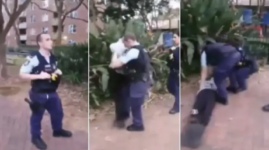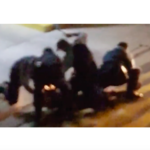NSW Police Officer Found Guilty of Assault For Slamming Teen to the Ground

A New South Wales Police Officer has been found guilty of assault occasioning actual bodily harm after slamming a 16-year old Indigenous youth into the ground in Sydney’s inner suburbs.
The defended hearing took place in Downing Centre Local Court yesterday, where Magistrate Rami Attia rejected Constable Ryan Barlow’s claim that he acted in self defence when he performed a leg sweep on the slightly built teen, causing him to fall face first into the ground and resulting in facial injuries.
Violent arrest
The incident occurred in Surry Hills in 2020 and was recorded by the arrested teen’s friends in footage that went viral.
That phone footage as well as police body worn camera evidence were central to the case.
They show the teenager in a stationary position four metres away from the officer when he states, “I’ll crack you across the fucking jaw, bro”. The teen stays where he is, when the officer tells him to turn around and get on the floor.
Just 3.02 seconds after giving the direction, Constable Barlow holds the teen’s arms behind his back and performs a violent leg sweep; a manouvre which – although not expressly banned – police are not trained to perform due to the dangers it presents.
The teen falls to the pavement face first, and the officer pins him to the him to the pavement using his knees to hold him, while he reached for handcuffs.
Not self-defence
The Magistrate rejected Constable Barlow’s claim that he acted in self-defence, stating:
“I cannot see what actions were taken by the complainant that constitutes a resistance to arrest”.
“There was no further threat. There was certainly no further abusive language.
“The risk of danger … was either minimal or nonexistent”.
His Honour noted the teen was “clearly and audibly in significant pain” and struggled to stand up when asked to do so, saying he could not feel his knee.
The Magistrate also noted the 16-year-old was of slight build, not armed and, while he did make a verbal threat, he did so from a distance and while stationary in a neutral pose.
Further, the teen did not run away when the officer approached him, nor did he resist when he was grabbed and spun around before having his legs kicked out from under him.
His Honour found on that basis the officer was not acting in self-defence, and was guilty of assault occasioning actual bodily harm.
Importance of footage
The case highlights the importance of video recordings of interactions with police, as it centred around footage taken by the teen’s friends as well as police body camera footage – both of which were inconsistent with the police officers version of the events.
As the National Justice Project’s Legal director Emma Hearne (who represented the teen and his family in court) said after the verdict: “…today’s outcome is likely a result of the footage which provided clear evidence of what occurred. I hate to think what could have happened if bystander footage wasn’t available.”
The issue of race
The assault against the Indigenous teen occurred just weeks after the killing of George Floyd, who died at the hands of police officers during his arrest in the US.
Floyd’s death was a moment which changed history – it sparked global condemnation of the racist treatment of people of colour at all levels of the justice system.
Here in Australia, George Floyd’s death meant taking a look at our own shameful history and the serious lack of political will there is to implement real change.
It has been 32 years since the tabling of the Royal Commission findings and since then, there have been almost 500 more Aboriginal deaths in custody.
Brutalising the elderly, vulnerable and disempowered
The incident has once again put the use of unreasonable and excessive force into the spotlight – at a time when the NSW Police Force is under intense public scrutiny for tasering a 95-year old dementia patient in a nursing home just last week.
That incident caused the family of an 81-year old dementia patient to release footage of officers using excessive force against the elderly, confused and terrified woman in 2020.
The offence of assault occasioning actual bodily harm
Assault Occasioning Actual Bodily Harm is an offence under section 59 of the Crimes Act 1900 which carries a maximum penalty of 5 years in prison, or 7 years where committed with another person.
To prove the offence, the prosecution must establish each of the following:
- That you committed an act of violence towards another person,
- The act caused physical injuries that were more than ‘transient or trifling’, or the act caused very serious mental harm,
- The other person did not consent to the act, and
- Your actions were intentional or reckless.
Examples of Actual Bodily Harm include:
- a deep scratch or lasting bruises
- a ‘black eye’
- a psychiatric condition
Legal defences to the charge include:
- Self-Defence,
- Duress, and
- Necessity.







